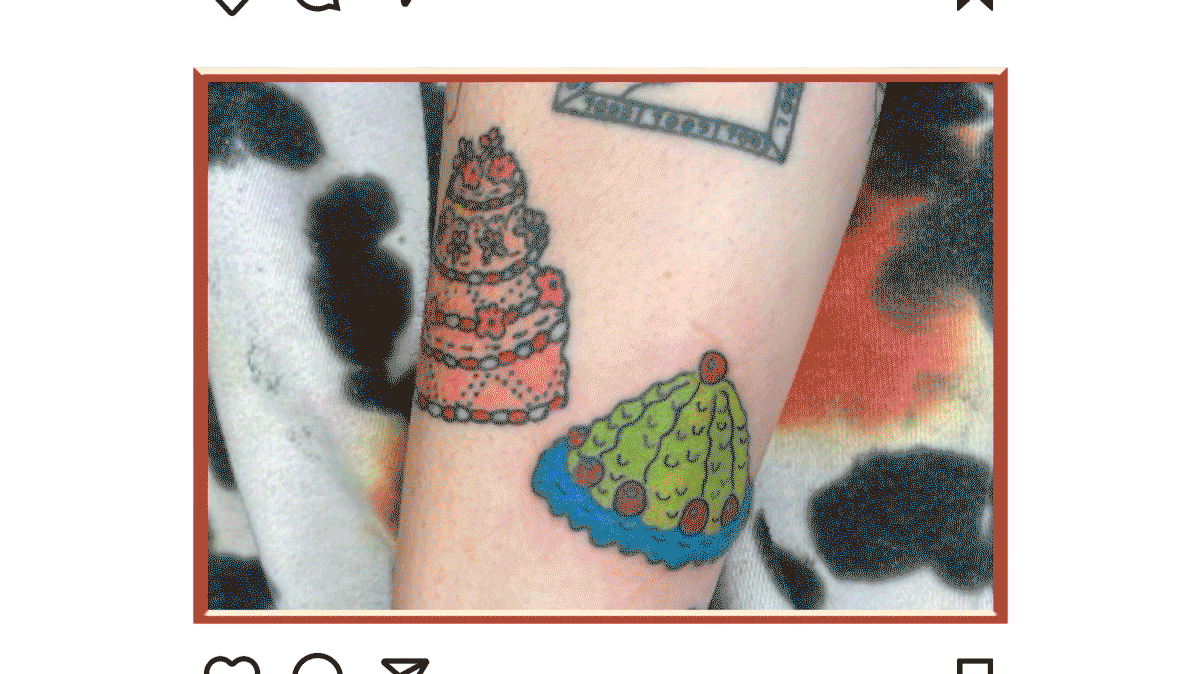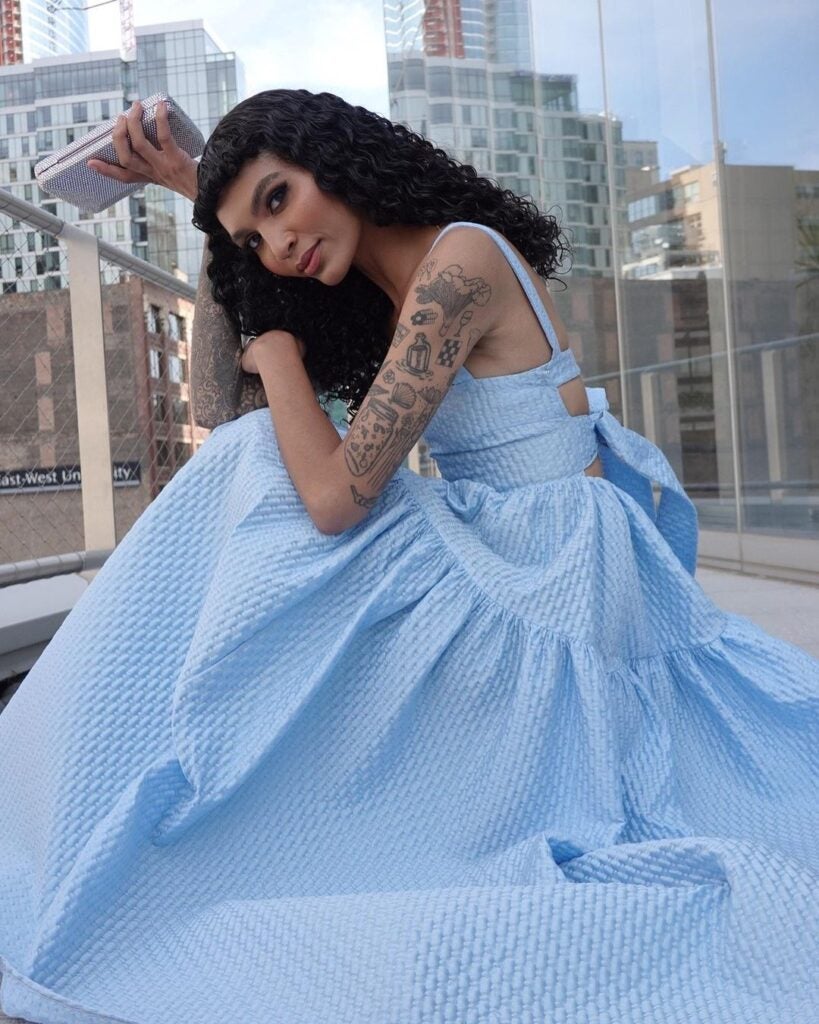
Chefs aren’t the only ones wearing their love for citrus on their sleeves
When I decided to get my first tattoo in the fall of 2020, I didn’t hesitate: I knew it would be fruit. A peeled tangerine, a halved lemon, and two small, plump figs, all clustered together in a three-inch still life. It was Caravaggio meets stick-and-poke, a composition that sounds wholly unique—until you scan the crowd at the Fort Greene farmers’ market or a buzzy LA pop-up. Dumplings dapple forearms; mushrooms sprout from knees. On my skin, and the skin of many others, it’s always citrus season.
In the early 2000s, tattoos were an overt chef signifier—especially food tattoos. You know the vibe: full sleeves filled out with true-to-size measuring cups, a long stalk of knobby Brussels sprouts, maybe a diagram of how to butcher a pig. Some part of the stereotype stems from line cooks’ early adoption of tattoos, an affinity nurtured by the restaurant industry’s counterculture mentality and lack of corporate culture. As chefs captured the public imagination, so did their tattoos. Anthony Bourdain began collecting his after the publication of Kitchen Confidential and continued until his death, which in turn prompted a wave of memorial tattoos.
Still lifes bearing hunks of holey Swiss cheese, crunchy baguettes, and martini glasses runneth over with gin are just one example of a surging new school of tattoos expanding the definition of “food people” and “tattoo people.” From fine-line depictions of chanterelles to technicolor Jell-O molds and an entire miniature cover of The Noma Guide to Fermentation (a real thing), a wave of tattoo artists and customers are expanding the significance, aesthetic, and demographic of “food tattoos.”
“On my skin, and the skin of many others, it’s always citrus season.”
In the ecosystem of Instagram, where artists can attract clientele and drum up desire for new flash tattoos, followings are built on the intersection of style and theme. It’s possible to rack up a customer base from specializing in produce or cakes alone, which is how I found Kelli Kikcio. The Brooklyn-based machine-free tattooer began offering still lifes as part of her flash (the book of designs currently available for tattoos, sometimes in highly limited quantities) around six years ago.
At first, she was staging and photographing the still lifes herself at home, even collaborating with a food stylist to arrange tableware and foods like thick clusters of grapes and glasses of sparkling wine. Then clients began asking to swap apples for lemons, incorporating tweaks that reflect their personal connections to food. Today Kikcio is one of several machine-free artists offering still lifes, prized for their hyperrealistic compositions and fine lines. “The cool thing with the correlation between food and art is that you don’t have to love a lemon to get a lemon tattoo,” Kikcio says. “You can like how its shape fits a spot on your body, and you can assign whatever meaning to it you want. I think the still-life genre has grown so much and been accepted by so many artists and clients because there’s such a tie to emotions and memory.”
While some of Kikcio’s clients are chefs, farmers, and food writers like me, others are teachers, social workers, and artists. “It’s not the same as the previous era, where I’m throwing a huge beet on my arm because I cook,” she says. “It’s more of, ‘I am existing as a human, and this is an experience that brings me pleasure and is part of my life.’”
As documented in books like 2016’s Knives & Ink, tattoos are an integral part of chefs’ public personas: the flaming wings on Danny Bowien’s forearms, Sean Brock’s cluster of colorful carrots, Matty Matheson’s entire body. In 2020, chef Ana Roš and the staff at her restaurant Hiša Franko in Kobarid, Slovenia, tattooed Michelin stars on their bodies after receiving two from the famed guide. (They left space for a third.) Kitchens overflow with ink—but also, “Tattooed Chef” is the name of a line of plant-based frozen foods like Buffalo cauliflower burgers and cauliflower-crust pizzas.
“I think my most ‘I am a chef’ tattoo is one-third of an inch; it’s a tiny whisk to memorialize my James Beard Award,” says Sophia Roe. The Brooklyn-based chef and host of the VICE TV show Counter Space got her first tattoo—a full sleeve—ten years ago. She’s since racked up more than 40 tattoos, over a quarter of them related to food, from a tea bag to a series of chive blossoms. All are ingredients, and none are complete dishes. “Food is my whole life, so it makes sense that I’m thinking about getting it tattooed a lot. Why do I want a big thing of grapes tattooed on my body but not a cake tattoo?” says Roe. “I’d rather cook cake than get a cake tattoo.”

But for others, the cake tattoo industry is booming. Ella Sklaw, an artist known for their Technicolor, folk-art-inspired style, had food tattoos sitting unclaimed in their flash book for years. “Now, all of a sudden, everyone wants cake tattoos,” they say. “I put one in my book, and I know it’s going to go immediately.” Sklaw looks for reference images in vintage Betty Crocker cookbooks, hoping to avoid mimicking hyper-recognizable cakes made by Instagram bakers like Gigi’s Little Kitchen or popular restaurants like Claud. “Some people get them because it was their birthday, or it can come off as a ‘screw you’ to the diet industry for fat clients,” they say. “And some people just love cake.”
Sklaw’s first cake tattoo was a towering, very pink, three-layer confection for Emma Zack, owner of the plus-size vintage boutique Berriez. (The shop was originally called Fruity Looms, until Fruit of the Loom sent a cease-and-desist letter). “The central theme is that humans are like fruit: uniquely sweet and desirable at any size, shape, or shade,” Zack says. The pink cake was an homage to her beloved vintage cake lamp, and while she says it’s the most complimented tattoo in her 30-plus-piece collection, it’s not the only food one.
There’s a jiggly Jell-O mold, a bowl of fruit, a milk carton, and a depiction of her favorite vintage sweater: a design from the brand Michael Simon emblazoned with a fruit bikini print. “There’s food art all around me, literally on my home, my clothes, and my body,” she says. “I’m a Taurus, and I love eating, and obviously there’s a lot of shit mixed up in being fat and liking food. I’m sure I can go so much deeper with it, but at the outset, I just love food.”
“I’m sure I can go so much deeper with it, but at the outset, I just love food.”
Kikcio attributes part of this interest to shifting stigmas in both the food and tattoo industries, simultaneously expanding aesthetic plates and clientele demographics. “I think the isolated objects that people were tattooing with bold, traditional lines ten years ago were related to the limitations that were said to be in tattooing then,” she says. “Now we have shifted the technique, and we can tattoo fine lines, tiny textures. Instead of just throwing on a few of your favorite fruits, I can create a messy tablescape that looks like how your table was left after you had your four best friends over.”
If magically brought to life, the full breadth of Evelyn Wang’s flash book could double as a grocery store: plump tomatoes on the vine, a raw egg dripping through its cracked shell, so many dumplings. Her Instagram handle, a nom de plume for many artists, is even @raw.egg.yolk. Some designs end up on bona fide “food people”—Wang says giving a tattoo of a pointillist-style cherry topped with whipped cream to a baker at Win Son Bakery was a “celebrity moment” for her—but for many, any significance is personal.
“Food has always been such an important part of how I connect to my Chinese culture, so it’s been really amazing and intimate to connect with my clients over our shared Asian American culture in general,” says Wang. “There’s a sense of reclaiming a food that maybe they didn’t used to want to identify with from bullying, or feeling disconnected from their culture in general, and being able to reconnect to it through food—but also, Jell-O is just really cool to look at.” A sleeve of chef’s knives may still point to professional kitchen experience, but for most, the takeaway is clear: We’re all food—and tattoo—people now.